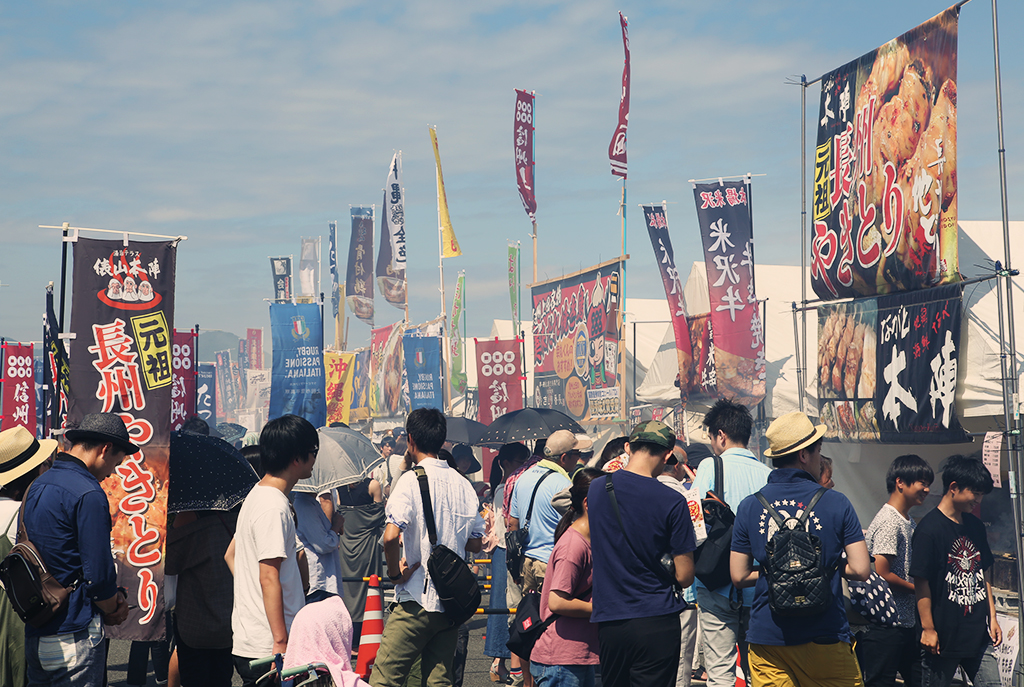- >
- Nanavi News
- >
- Famous Yakitori restaurants from all over Japan gather in Nagato
Famous Yakitori restaurants from all over Japan gather in Nagato
-
Last updated:
Sep 4, 2018
-
About the writer:
Nagato Tourism Convention Association

Held the 12th National Yakitorinpic in Nagato
On Saturday, September 1, "National Yakitori Festival in Nagato" started in the rain. This was the third time in four years that Nagato City, known as one of the "seven major yakitori towns in Japan," hosted the event.

Nineteen famous local yakitori restaurants from all over Japan will be lined up at the venue.
In addition to the skewer style familiar to Nagato residents, "local yakitori" can be prepared in a variety of ways, such as fried in oil or grilled with the bones still attached.




By evening, the weather had cleared up and the second day of sales began under blue skies.
Three stores from Nagato City, Chikuzen Sohonten, Nagato Honjin, and Fukagawa Chicken Farmers Cooperative, continued to grill yakitori using fresh Choshu chicken and Choshu black kashiwa.




From Hokkaido in the north to Okinawa in the south.
The venue was filled with savory smells and smoke as people lined up from start to finish in front of the yakitori stores, repeatedly wiping off their sweat.



Enjoy Yakitori inside the fish market
After picking up a variety of yakitori (grilled chicken), visitors went to the spacious eating and drinking area inside the fish market.

Yakitori with beer!
The staff of the draft car will continue to provide as much as the yakitori restaurants.

While the adults were enjoying a blissful moment, the children were also enjoying a yakitori (grilled chicken) eating contest!
Delicious!" We received such voices and expressions.


A place where you can encounter the "deliciousness" of Nagato
Yakitori is not the only specialty of Nagato City.
The "Nagato Products Market," a space for local products, was also very lively.
Freshly grilled abalone and turban shells, "Nagatorimen" ramen noodles that are full of chicken from soup to chashu pork, and "Semura oysters" from Aomi Island. Cheerful voices and smiling faces enliven the market.



Senzaki Kamaboko Kumiai's menu for sale is freshly fried fish cakes.
It is said that the poultry farming industry flourished in Nagato City because the city had access to large quantities of cheap fish ara, which were used as chicken feed, along with the production of fish cakes, which had flourished in the city for a long time.
Yakitori and fish cake booths in the same hall. This is a scene from the history of yakitori in Nagato.

Abundant agricultural products and Italian breezes
The previous venue for the Yakitori Olympics was Florence, Italy.
Students from the "Italian National Culinary School SAFFI," which served as the venue for the event, also came to Japan for the Yaki to Rinpik and tried their hand at making pizza using "Choshu Black Kashiwa" and Nagato's traditional vegetable "White Okra.

In the space lined with processed agricultural products, visitors could find a variety of sweets made from rice and fruits, and the "Nagato Yuzukichi" juice was especially popular. The freshly squeezed juice and refreshing acidity made this a perfect summer drink.



A stage where visitors become one.
Over the two days, numerous performers enlivened the venue on the main stage.
Singer-songwriter Ayaji Shigemura, a native of Nagato City, performed, followed by a performance by the Nagato Street Dance Club.


TAIZO, a native of Awano, Toyokita-cho, Shimonoseki City, gave an impersonation show on both days.

Although it was raining lightly on the first day, the venue was filled with laughter and brightened up at once.

After the second day's impersonation show, a commemorative photo was taken with the visitors.
A sense of unity was created in the venue, and it was the most exciting event of the day.


In the evening of the second day, as the sun begins to set, the stage reaches its finale.
A performance by the city's brass band "Rakurakudan" and a chorus by the "Misuzu Boys and Girls Choir.


In the end, the two groups collaborated to create a beautiful sound and voice that echoed through the hall.

Approximately 65,000 people visited the event over the two days, and a total of 110,000 skewers were served at all the restaurants.
The two days at the Yakitori restaurant made me realize once again the power of Yakitori.
We will continue to promote Nagato City, a major chicken production area and a city where the yakitori culture has taken root, as a "sacred place for yakitori". When you visit Nagato City, please try our Yakitori.



Related Links
Special Feature: "Yakitori no Machi, Nagato" (Town of Yakitori, Nagato)


